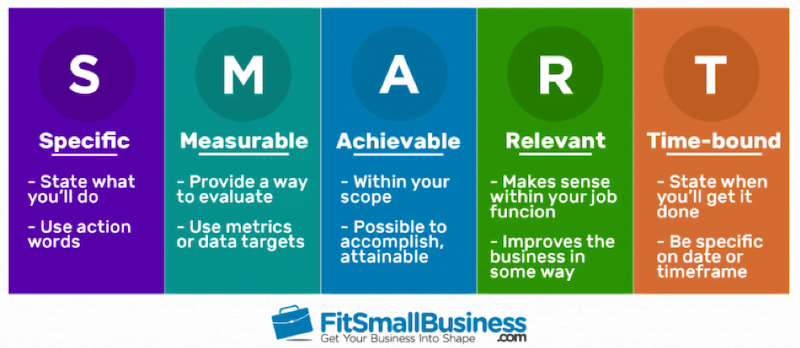Most of us want to know what our goal is before we start a project. But when it comes to business, too many marketers fly by the seat of their pants—and that’s a huge mistake. Why? Because marketers who create a clear, documented strategy are 313% more likely to be successful.
Creating marketing strategies before defining your marketing objectives is putting the cart before the horse.
That’s why today we are going through everything you need to know to make sure you’re setting your business up for success with actionable, effective marketing objectives. Here’s what we’ll cover:
- What marketing objectives are
- How they are different from marketing goals
- How to create marketing objectives for your business
Let’s get started.
What are marketing objectives?
Marketing objectives are actionable targets designed to provide not just overall direction, but clear and specific actions. They are specific, measurable, attainable, relevant, and time-based (These are often called SMART goals, an acronym you’ve likely heard before!).
Marketing objectives should be tied to the overall success of the company, not just an arbitrary number.
For example, a marketing goal might be to increase website traffic by 50%.
But how will you get there and what will the purpose of that traffic be? When do you want to hit that number?
Objectives outline more than just a specific number, but also how you plan to reach that number and what impact that endpoint will have on the company as a whole.
Give it to me straight—what’s the difference between a marketing objective and a goal?
Goals and objectives are two sides of the same coin. In general, business goals define the endpoint, while objectives are a more specific outline of how your marketing team will get there.
These terms are often used interchangeably and may have different definitions at different companies. For digital marketers, however, they have distinct differences:
- Marketing objectives are specific, measurable objectives designed to provide both instruction and targets.
- Marketing goals are broader destinations designed to outline how your business can benefit from digital marketing efforts.
Why do marketing objectives matter so much?
Without defined objectives, your marketing goals will lack clarity and follow-through.
Peter Druker, a well-known management writer, once said: “If you can’t measure it, you can’t improve it.” And while the phrase may or may not have been original, the truth of it stands the test of time.
When digital marketers don’t take the time to outline objectives and measure their impact, they can’t tell if their efforts have had any impact.
What are the key features of effective marketing objectives?
Marketing objectives should follow the SMART philosophy to be effective. This means they need to be specific, measurable, attainable, relevant, and time-based.
Specific: Specific metrics should be used in your marketing objectives. Don’t just say you want to increase sales—say how much you want to increase sales by, either in a percentage or a dollar amount.
Measurable: Objectives must be measurable, and you should outline how you will measure success. Your goal might be to increase brand awareness, but your objective must include how you will measure it—for example, by measuring an increase in organic brand searches, social mentions, or social followers.
Attainable: You might want to increase sales by 200%, but is that objective really attainable? Make sure the benchmarks you set are reasonable and attainable—and outline what steps are required to reach that objective.
Relevant: One of the major drawbacks of goals is they outline the destination, but not how reaching that benchmark will impact the overall marketing strategy as a whole. Objectives should be relevant to the overarching purpose of your business.
Time-Based: Finally, objectives should include a reasonable time frame for reaching the specific benchmark. Most marketing objectives are based on year or financial quarter, but that may vary based on the objective and how much work is required to reach the benchmark.
Marketing objective examples
All of this sounds great, but how do marketing objectives work in real life? Below, we’ve outlined several marketing objectives—including how those objectives will be tracked. These examples can be used as inspiration when creating your own objectives.
Increase sales
If you sell products or services, you might want to focus on increasing sales to increase revenue. For example, your objective might be: “Increase sales by 15% in the next six months by increasing new signups by 10% and increasing average customer orders by 20%.”
Then, outline how you will get there—perhaps by increasing lead generation content production or automating your email marketing to suggest related products.
Increase leads
If you offer an expensive product or are in the B2B market, you might want to increase the number of people who land in your sales pipeline so you can work to convert those folks over time.
Your objective might be “Boost the number of clients by increasing the number of leads by 25% in the next year by launching two new lead generation funnels on our website.”
Grow brand awareness
If you are a new company or are launching a new product or service, you may be interested in growing your brand awareness to increase sales. This goal can be difficult to track without a clear objective.
Here’s what your objective might look like: “Increase market share by improving brand awareness in the next 12 months, as measured by an increase in organic brand name search by 50% through social media saturation, social media ads, and an influencer campaign.”
Note that this objective not only outlines the target to increase brand awareness but also how you will measure it—through an increase in organic searches of your brand name.
Decrease churn
Maybe you are a well-established company and have a decent sales funnel—but you have a hard time keeping customers. Since it is cheaper to keep customers you’ve already earned than bring in new customers, you might create an objective to decrease customer turnover.
Your objective might look like this: “Decrease customer churn by 5% in the next quarter by decreasing customer service wait times by 15%, and nurturing customers through email automation.”
Increase trial signups
If you are a SaaS company, a key performance indicator is likely how many trial signups you get per month. An objective for trial signup might be: “Increase trial signups by 25% over the next six months by increasing guest posts and using retargeting to push social followers to sign up for a trial.”
Your overall goal might be to increase sales, but your objective is to increase signups over the next six months.
Increase website traffic
Businesses just getting started or looking to increase their market share may be looking to drive website traffic in an effort to increase brand awareness, sales, and overall growth.
An objective focused on increasing website traffic might have an executive summary that looks like this: “Increase unique website visitors by 20% by the end of the fourth quarter of 2020 through guest posts, social promotion, and link building.”
A fully developed plan would likely include details about how many guest posts, what types of social promotion, and link building strategies.
5 steps to create actionable marketing objectives
Now that you understand what marketing objectives are and why they matter, you are ready to create your own. But what does the creation process look like? Should you create a strategy or figure out what your objective is first?
We’ve created a five-step process to help create useful, measurable marketing objectives.
Step #1: Outline your main marketing objective
What is the main outcome you are looking for? Do you want to increase sales, improve customer retention, get better quality leads?
Remember that your objective should be specific and measurable, not just a generic declaration.
For example:
Get more website traffic X
Increase website traffic by 20% in 6 months ✓
Grow sales X
Increase sales to $100,000 in 1 year ✓
Get more customers X
Reach 25,000 signups 6 months after launch✓
Step #2: Set short-term goals
What short-term goals are going to help you reach your marketing objective? Will you set time-based benchmarks? Increase specific actions, such as creating more content? How will you measure if your marketing objectives are attainable in six months?
For example, your objective might be to reach 25,000 signups for your SaaS company six months after launch. Where do you expect to be at one, two, or three months? Have you accounted for the time it may take for SEO or content marketing efforts to be effective?
Step #3: Outline your marketing strategy
You know where you are going, but how will you get there? This step is where you outline the strategies you will use to reach your objectives.
So, if your objective is to increase website traffic by 20% in six months, your marketing strategy might include:
- Create an SEO-driven content marketing plan.
- Write and publish three or four guest posts per month.
- Use Facebook ads to drive traffic to your website.
Step #4: Coordinate your objectives and long-term goals
This step is about reflection—do the strategies you have outlined match your main objective and your short term goals? Do you have buy-in from executives or department managers, and are there any holes in your current strategy?
Most marketing strategies are not created by a single person—or even a single department. A brainstorming session can be helpful, but it can also pull your objectives off target if you don’t take the time to ensure every step of your strategy makes sense for your main objective.
Finally, make sure your objective and strategy support your business’ long-term goals for growth.
Step #5: Measure your results
To complete this step, you first need to determine how you’re measuring the results. Are you using Google Analytics to measure traffic or another tool? Will you use WordStream to track the success of your Facebook campaign or another tool? Will you use UTM links to track social traffic, or do you need to create a goal in Google Analytics?
Decide how you will measure, what you will measure, and how often you will take these measurements. Get clear on these before you launch your campaign—otherwise, you risk having data you can’t accurately compare.
For example, if you track unique site viewers for the first month, but then switch to overall traffic the second, it will be more difficult to tell what efforts are making a difference because you are comparing different data sets.
Set yourself up for success with marketing objectives
Effective marketing starts with clear, measurable marketing objectives that are relevant to short-term goals and tied to marketing strategies. When you know where you are headed, your team is better prepared to measure success as you go and make necessary adjustments.











0 Comments